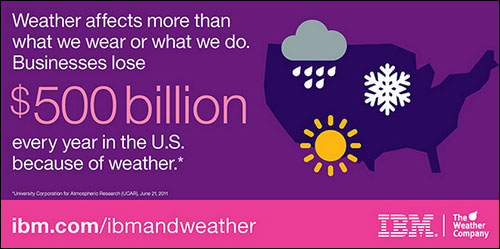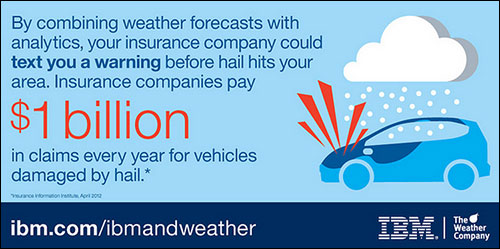This week, IBM announced a new partnership with The Weather Channel and its Weather Services International (WSI) business arm, which provides customized forecasts and related services to businesses. WSI is migrating its weather data platform service, which continuously pulls data from sensors and weather stations around the world, from its own data centers to the IBM cloud.
This integration will enable three distinct offerings, IBM reports: industry-specific data services based on historical and real-time weather data, as well as input from IBM analytics platforms; Bluemix, IBM’s cloud application development platform, consisting of tools for developers to create Web-based applications that leverage this integrated solution; and access to IBM Global Business Services consultants, who are training to become WSI data experts in order to help clients make use of weather data. (IBM has also announced that is it investing $3 billion during the next four years to create an IoT business unit.)

The two companies are targeting specific industries that they say will see immediate benefits by integrating weather datasets into their operations: insurance, energy, utilities, retail and logistics. They cite research from the Bulletin of the American Meterological Society that shows weather is linked to $500 billion in annual losses for firms in the United States.
But how does weather data play into the Internet of Things? By enabling better decision-making, says Bryson Koehler, WSI’s chief information and technology officer. WSI already supplies companies in a range of industries, including aviation, insurance and energy, with weather data that is designed to help them foresee and respond to weather events that will impact their business.
For example, WSI collects data from sensors mounted on airplanes to power its turbulence-alert system, which helps pilots better understand and avoid areas of rough conditions ahead of them. Through the IBM partnership, WSI’s customers in the aviation industry will be able to integrate other datasets, related to their operations or how they are being discussed in social media. This will enable them, for example, to get a more complete picture of not just turbulent air and how to avoid it, but also how turbulence during flights impacts other parts of the company’s operations, such as fuel consumption, or how it sways customer sentiment.
Despite all of the hype and tantalizing forecasts regarding the IoT’s market potential, Koehler says, “Real-time business tools have not been [deployed] at scale yet. When you look at IoT datasets that are being captured around world, most of it sits in silos.” The IBM-WSI partnership, he adds, will be one of the first to show how a large-scale data platform allows IoT datasets to be captured and combined at scale. “We can take operational data, weather data [and] social data, and then drive Web-based application tools” that companies can use to improve their business.
A company would not necessarily need to harvest social-media data to find weather data integration useful, of course. But it is easy to imagine how a retailer might be better prepared to keep shelves stocked with a certain brand of rain boots if it knew, for instance, that it was about to be hit by the perfect storm of a social-media-trending photo of Kim Kardashian wearing those boots, and an actual storm. That does not mean weather data integration will make or break a retailer, and adding weather forecasts to its mix of data analytics does not mean it will necessarily be able to keep shelves stocked.
Certainly, weather impacts some industries more than others. According to IBM, the insurance industry takes a $1 billion hit each year just through claims related to hail-damaged vehicles in the United States. WSI already offers weather-forecasting mobile applications that insurance companies offer to policyholders, to alert them to hazardous conditions. But integrating weather data with a customer relationship platform could power more complex pre-emptive measures, such as sending text messages to policyholders based on their location and alerting them to, say, a hailstorm heading their way. If this gives them enough time to move their cars from harm’s way, IBM figures, insurers could save up to $25 per policyholder per year in hail-prone areas.

The energy sector is another area that WSI and IBM are targeting, since operational costs are so tightly aligned with outages, which are usually caused by weather. But weather also drives energy generation, as does climate. This past winter has been markedly stormy on the East Coast, which led to below-average energy output from solar-power plants located in that section of the United States—while those on the West Coast performed better than expected. Insights into both short- and long-term forecasts can help utility providers not only avoid outages, but also optimize the alternative energy sources that feed into the energy grid.
Being able to quickly analyze and respond to weather patterns could be even more useful for operators of microgrids, on which towns and cities are increasingly relying in order to leverage nearby solar- and wind-power installations. Microgrid operators already use sensor networks to enable smooth transitions between energy sources—in fact, the second Industrial Internet Consortium testbed is developing best practices for that process. Feeding real-time weather data into that decision-making architecture could help operators further optimize those energy resources.
Koehler says his job is all about making weather data relevant to businesses, but that the partnership with IBM shows that weather can be an integral part of the IoT as well. “There is a massive business opportunity behind it,” he states.

